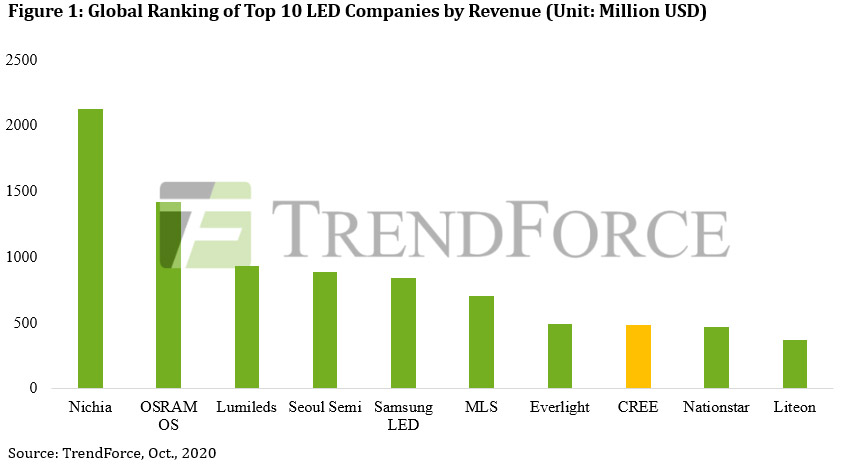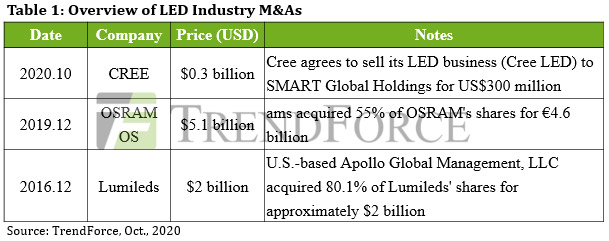News: LEDs
23 October 2020
Cree divesting LED business at low price, says TrendForce
After Cree Inc of Durham, NC, USA divested its Lighting Products business in May 2019, the company earlier this week announced plans to sell its LED Products business to SMART Global Holdings Inc (SGH) for $300m. Market research firm TrendForce indicates that, benefiting from superior production capacities and cost-optimization measures, Chinese manufacturers have quickly risen in the LED industry in recent years, and are continuing to capture market share from major overseas LED companies such as Nichia, Osram Opto Semiconductors (OS), Lumileds, and Cree. Furthermore, given the poor state of the global economy in the past two years, companies that were previously dominant in the LED industry must now deal with the difficult reality of having their business operations or stocks sold off to other companies.

Cree’s LED packaging and lighting businesses generated more than $1bn in annual revenue for the 2013-2014 period. At the time, its LED business ranked second only to that of Nichia in terms of revenue. However, in light of competition from Chinese companies fielding aggressive pricing strategies and the gradually slowing growth of the LED lighting market in recent years, Cree’s annual LED revenue was just $480m in 2019, and the firm’s global ranking slid from among the top three to eighth place.
Final price of Cree’s LED business limited by regulatory complications with US aerospace & military technologies
According to TrendForce, Cree is estimated to sell its LED Products business for a mere $300m, a far lower price compared to similar transactions by Lumileds and Osram OS. This low price is primarily due to the myriad restrictions and export controls by the US government specifically targeting sales of technology companies. In addition to Cree’s role as a supplier of LED lighting products, the company’s subsidiary Wolfspeed offers a range key components made from silicon carbide (SiC). As Wolfspeed has been in close collaboration with the aerospace & defense industries in the USA, it possesses a significant number of sensitive technologies.

On the other hand, the primary advantage of Cree’s LED technologies comes from the fact that its SiC substrates massively boost the overall performance of its LED products. Since it is difficult to separate Cree’s LED-related patents/technologies from its SiC technologies, potential buyers of Cree’s business are therefore limited to US-based parties, in turn placing a limit on the final sales price.
LED supply chain to continue gradual transition to Asia, while Cree may look for chip OEM partners
Under intense pricing pressure from its competitors, Cree has in recent years gradually outsourced its LED business to OEM partners with mature technologies, including Fujian Lightning Optoelectronic and Lextar. TrendForce notes that, even with the upcoming ownership transfer of its LED business, Cree is still an important client of its OEM partners, and its management structure will not change in the short term. That is why the overall trend of the LED supply chain shifting to Asia has not changed, says TrendForce.
In addition, SMART Global Holdings does not have a need for SiC substrate development, so it will likely adopt a more flexible business strategy that involves looking for Asia-based chip OEM partners in the future, the market research firm concludes.
Cree selling LED business to SMART for up to $300m
Cree completes sale of Cree Lighting to Ideal Industries








